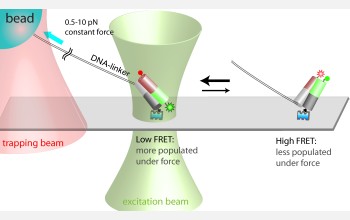|

Press Release 07-141
New Technique Reveals Subtle Force-induced Changes in Biomolecule's Conformation

Discovery is essential step in developing therapies for genetic disorders
October 12, 2007
Scientists studying biological systems at the molecular level now have a new hybrid technique to probe the dynamics of the Holliday junction. The Holliday junction is a four-stranded DNA structure that forms during a process known as homologous recombination, which occurs when damaged DNA is repaired. Understanding how DNA repairs itself is an essential step in ultimately developing therapies for genetic disorders. The hybrid technique is described by principal investigator Taekjip Ha and his colleagues at the University of Illinois in the Oct. 12 issue of Science. The Holliday junction is named after geneticist Robin Holliday, who proposed the model of DNA-strand exchange in 1964. To better understand the mechanisms and functions of proteins that interact with the Holliday junction, the researchers needed a way to study the structural and dynamic properties of the junction itself. "Based on our previous studies, we knew the Holliday junction fluctuated between two structures, but how it moved from one place to the other and what intermediates were visited along the pathway were unknown," Ha said. With this latest work, the researchers have determined that the intermediate structure is similar to that of a Holliday junction bound to its own processing enzyme. The hybrid technique combines the exquisite force control of an optical trap and the precise measurement capabilities of single-molecule fluorescence resonance energy transfer. To use the technique, researchers first attach two dye molecules--one green and one red--to the molecule they want to study. Next, they excite the green dye with a laser. Some of the energy moves from the green dye to the red dye, depending upon the distance between them. The changing ratio of the two intensities indicates the relative movement of the two dyes. Therefore, by monitoring the brightness of the two dyes, the researchers can determine the motion of the molecule. With the optical trap, a focused laser beam locks onto a microsphere attached to one end of the molecule to be studied. The optical trap can then pull on the molecule like a pair of tweezers. The project is funded by the Physics and Molecular and Cellular Biosciences divisions at the National Science Foundation (NSF) through a CAREER award for the development and utilization of advanced single-molecule techniques to study the fundamentals of DNA-protein interactions. Past techniques, such as X-ray crystallography and nuclear magnetic resonance, have provided a vast amount of structural detail for biological molecules, but the data is largely limited to a static view. Single molecule approaches make it possible to study dynamic interactions at the single molecule level. The ability to follow bioprocesses as they actually occur in real time transforms the way we visualize and ultimately understand the complex dynamics of living systems. "The two NSF divisions supporting this project have been working closely together for several years to foster this research and other similar approaches," said NSF Program Manager Denise Caldwell. "These results highlight the importance of fostering a cross-disciplinary approach to understanding complex living systems because input from both directions is essential to the success of the project." She added that "a lot of junior scientists are migrating into fields like this one because the science is intellectually exciting."
-NSF-

Media Contacts
Diane Banegas, National Science Foundation (703) 292-4489 dbanegas@nsf.gov
Diana Yates, University of Illinois at Urbana-Champaign (217) 333-5802 diya@uiuc.edu
Program Contacts
Denise Caldwell, National Science Foundation (703) 292-7371 dcaldwel@nsf.gov
Principal Investigators
Taekjip Ha, University of Illinois, Urbana-Champaign (217) 265-0717 tjha@uiuc.edu
Related Websites
Single Molecule Biophysics Group: http://bio.physics.uiuc.edu/
UIUC news release: http://www.news.uiuc.edu/news/07/1011fluoroforce.html

The National Science Foundation (NSF) is an independent federal agency that supports fundamental research and education across all fields of science and engineering. In fiscal year (FY) 2009, its budget is $9.5 billion, which includes $3.0 billion provided through the American Recovery and Reinvestment Act. NSF funds reach all 50 states through grants to over 1,900 universities and institutions. Each year, NSF receives about 44,400 competitive requests for funding, and makes over 11,500 new funding awards. NSF also awards over $400 million in professional and service contracts yearly.
 Get News Updates by Email Get News Updates by Email
Useful NSF Web Sites:
NSF Home Page: http://www.nsf.gov
NSF News: http://www.nsf.gov/news/
For the News Media: http://www.nsf.gov/news/newsroom.jsp
Science and Engineering Statistics: http://www.nsf.gov/statistics/
Awards Searches: http://www.nsf.gov/awardsearch/
| 

